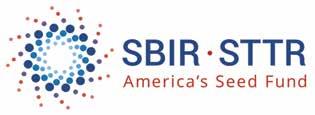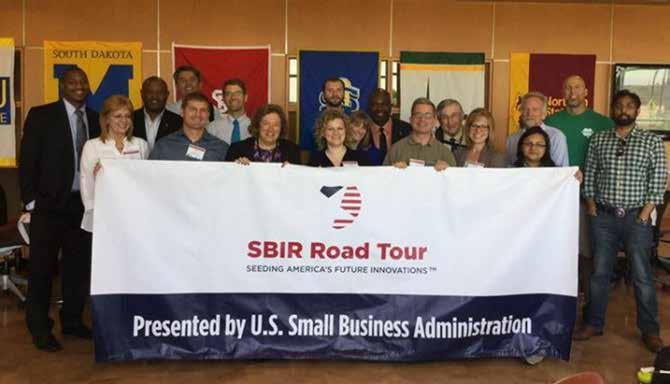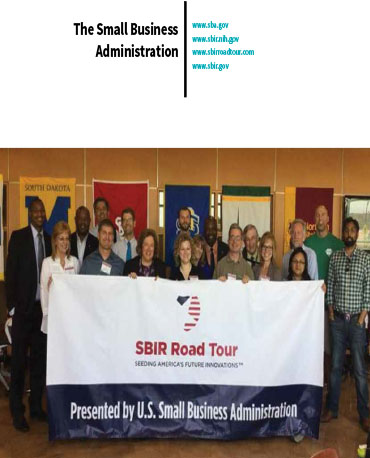The Small Business Administration
 Small businesses are the creators of jobs and the driving force behind the US economy. Recognising this truth, the US government established the Small Business Administration (SBA) in 1953 in order to help Americans start and develop their own small businesses. As part of this initiative, the Small Business Innovation Research (SBIR) and Small Business Technology Transfer (STTR) programs support early stage businesses that wish to commercialise innovative biomedical technologies. Between them, these two programs awarded $2.5 billion dollars of seed-funding directly to small businesses last year alone. Over the next few pages we talk to Nagesh Rao, the Chief Technologist, and Chris McNeal, Presidential Management Fellow of the SBA, who give us an overview of the organisation, and describe the ways in which the SBIR and STTR programs help small companies engage in R&D, bring life-saving technologies to the market and create jobs.
Small businesses are the creators of jobs and the driving force behind the US economy. Recognising this truth, the US government established the Small Business Administration (SBA) in 1953 in order to help Americans start and develop their own small businesses. As part of this initiative, the Small Business Innovation Research (SBIR) and Small Business Technology Transfer (STTR) programs support early stage businesses that wish to commercialise innovative biomedical technologies. Between them, these two programs awarded $2.5 billion dollars of seed-funding directly to small businesses last year alone. Over the next few pages we talk to Nagesh Rao, the Chief Technologist, and Chris McNeal, Presidential Management Fellow of the SBA, who give us an overview of the organisation, and describe the ways in which the SBIR and STTR programs help small companies engage in R&D, bring life-saving technologies to the market and create jobs.

To start, please briefly introduce the SBA, and tell us about its history and focus.
The Small Business Administration (SBA) is an independent federal agency created in 1953 to ‘aid, counsel, assist and protect the interests of small business concerns, to preserve free competitive enterprise and to maintain and strengthen the overall economy of our nation’. The SBA helps Americans start, build, and grow businesses. The Agency utilises an extensive network of field offices and partnerships with public and private organisations to deliver services throughout the United States, Puerto Rico, US Virgin Islands and Guam. Since our founding, the SBA has delivered millions of loans, loan guarantees, contracts, counselling sessions, and other forms of assistance to small businesses throughout the country. The Office of Investment and Innovation focuses on the Small Business Investment Companies (SBICs), Growth Accelerators, Small Business Innovation Research (SBIR), Small Business Technology Transfer (STTR), and Federal and State Technology Partnership (FAST) programs. Chris and I primarily focus on the SBIR and STTR programs, where the SBA serves as the coordinating agency for the eleven participating agencies. SBA directs the agencies’ implementation of SBIR and STTR, reviews their progress, and reports annually to Congress on its operation. In the midst of overhaul and revamping of SBIR.gov, among many other programmatic endeavours, we at SBA were fortunate to hire at the end of 2014, John Williams into a Senior Executive Service role as the Director of Innovation and Technology lead for policy and programmatic oversight of the program. He brings his experience and success from leading the Navy SBIR program to help our SBA team in building out successful efforts across the 11 agencies.
In what ways are the SBIR and STTR programs able to promote and support small businesses to engage in Research and Development?
SBIR targets the high-tech entrepreneurial sector because that is where most innovation and innovators thrive. However, the risk and expense of conducting serious R&D efforts are often beyond the means of many small businesses. By reserving a specific percentage of federal R&D funds for small businesses, SBIR protects the small business and enables it to compete on the same level as larger businesses. SBIR funds the critical start-up and development stages and it encourages the commercialisation of the technology, product or service, which in turn stimulates the US economy. Since its enactment in 1982, the SBIR program has helped thousands of small businesses to compete for federal R&D awards. Their contributions have enhanced the nation’s defence, protected our environment, advanced health care, and improved our ability to manage information and manipulate data. SBIR’s mission is to support scientific excellence and technological THE SMALL BUSINESS ADMINISTRATION innovation through the investment of federal research funds in critical American priorities to build a strong national economy. Its goals are to stimulate technological innovation, meet federal R&D needs, foster and encourage participation in innovation and entrepreneurship by socially and economically disadvantaged persons, and to increase private-sector commercialisation of innovations derived from federal R&D funding. The STTR program also expands funding opportunities in the federal R&D arena. Central to the program is expansion of the public/private sector partnership to include joint venture opportunities for small businesses and non-profit research institutions. The unique feature of the STTR program is the requirement for the small business to formally collaborate with a research institution in Phase I and Phase II. STTR’s most important role is to bridge the gap between performance of basic science and commercialisation of resulting innovations. The mission of the STTR program is to support scientific excellence and technological innovation through the investment of federal research funds in critical American priorities to build a strong national economy. Its goals are to stimulate technological innovation, foster technology transfer through cooperate R&D between small businesses and research institutions, and to increase private sector commercialisation of innovations from federal R&D. Iconic companies that have resulted from our program have included Qualcomm, Symantec, Biogen-Idec, iRobot, Intuitive Surgical, LiftLabs, Made in Space, Ecovative Design, Natel Energy, Oceanit and Orbital ATK.
What are the greatest challenges that currently shape the public/ private sector partnership agenda?
Balancing the needs of the various stakeholders involved in small business companies, major corporations, and academic institutions to name a few. Each entity is going to see the path to success differently and will have different timelines as well end goals in mind. Thus it’s critical to goal-align as much as possible and allow each stakeholder to do what it does best in helping shape a more positive future.
In order to address these challenges, how does the SBA promote co-operation between companies and researchers across different disciplines and from different institutions?
The SBIR and STTR programs are excellent examples of the SBA’s efforts to promote cooperation between companies and researchers across different disciplines. Eleven agencies participate in the SBIR program and five of those eleven agencies also participate in the STTR program. Companies and research institutions are able to search for opportunities on our website (sbir.gov). It is not uncommon for the same company to compete for and win funding from multiple agencies over the course of developing their product. There are also numerous examples, such as iRobot and Hydronalix, where companies sold their commercialised SBIR and STTR funded projects to multiple audiences. The SBA also continues to look for ways to improve our outreach and engagement efforts to ensure that we are reaching underserved communities. We host a series of SBIR Road Tour stops across the country to convey the message of the program. Entrepreneurs can meet with program managers at these events to discuss the program, ask questions, and learn about funding opportunities. The SBIR program is hitting the Road this April to get the word out about the program across the country. Be sure to visit www.sbirroadtour.com for more details and to find out what city we will be coming too this year.
The SBIR and STTR programs are designed to award contracts and grants to US-based companies to drive innovation and commercialisation.

Do the SBIR or STTR programs support international collaboration? What funding is available to promote business that might not be entirely US based?
The SBIR and STTR programs are designed to award contracts and grants to US-based companies to drive innovation and commercialisation. The SBA can however connect small businesses with resource partners who specialise in international support functions. Our office has also met with foreign delegations to discuss how our programs operate and we make efforts to work with our sister agencies, International Trade Administration and US State Department to assist on helping US firms figure out appropriate global scale up opportunities.
Considering the great range, and variety, of research that is undertaken in the USA, how do the SBIR or STTR programs ensure that the available funds are best allocated?
Each agency sets the criteria for their proposed contracts and grants. The company or research institution must meet the qualifications of the proposal and compete for the funding. The SBA oversees the government-wide SBIR and STTR programs, but does not control which projects are awarded. SBA authorises award amounts above the statutory limits and sets the guidelines for the program governmentwide. However, while the SBA does not control the allocation of funds, we know that the program is highly competitive. Approximately 15% of proposals are awarded Phase I funding, and only 25% of those proposals are awarded Phase II funding. We know that the proposals are high risk, and we have witnessed high rewards across multiple sectors. SBIR and STTR funded concepts drive innovation, and that spirit produces products that revolutionise our lives. Over the lifetime of the program we have invested around $40 billion into cutting edge high tech small business companies, and merely scratching the surface, Qualcomm and Biogen alone have a collective market cap of $120 billion essentially tripling the ROI of the program.
Please tell us a little about the SBA’s position on public engagement and knowledge dissemination.
One of the critical aspects of our programs is that the entrepreneur retains the intellectual property rights to their ideas and that your data is protected. Data generated from the entrepreneur’s federal Research or R&D is protected from public disclosure for a minimum of four years (civilian agencies) or five years (DoD) after the conclusion of the award. During this time, we encourage the entrepreneur to secure patents on their work. We want to preserve their intellectual property rights, which the small business company gets to retain per discretion of the Bayh-Dole act. Furthermore, we offer non-diluted funding (no equity taken). We are constantly working on expanding the awareness of our programs. The SBA hosts a variety of SBIR Road Tour events, targeting underserved states, in addition to events such as our National SBIR/ STTR Conference.
Please tell us about your views on the value of direct engagement with regards to small businesses collaborating with research institutions.
One unique feature about the STTR program is the requirement for small businesses to formally collaborate with a research institution during Phase I and Phase II. This partnership is essential to bridging the gap between basic science and commercialisation. In other words, helping to facilitate effective cooperation and technological de-risking by high tech small business firms portioning some of their STTR funding to a research institution to aid in the necessary R&D. SBIR and STTR are highly competitive programs that encourage domestic small businesses to engage in federal Research or R&D that has the potential for commercialisation. Through a competitive awards-based program, SBIR and STTR enables small businesses to explore their technological potential and provides the incentive to profit from commercialisation. Including qualified small businesses in the nation’s R&D arena stimulates high-tech innovation and fosters entrepreneurial spirit while ensuring the government meets its specific research and development needs.
Finally, can you please share your thoughts on the future of research commercialisation, and the ongoing role of the SBA in that future?
SBA will continue to ensure that small businesses continue to have opportunities to drive research and development commercialisation. We are continuously improving our outreach and engagement efforts to ensure that the program reaches all corners and communities of our nation. We are currently working with our partners in Congress to reauthorize the SBIR and STTR programs. Last fiscal year, the SBIR and STTR programs provided over $2.5 billion dollars of seed-funding directly to small businesses nationwide. The SBA will continue to work closely with our sister agencies to ensure that these programs are top priorities across the federal government.

